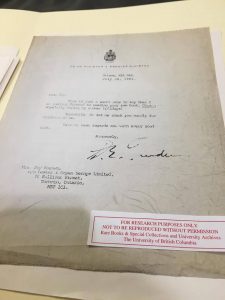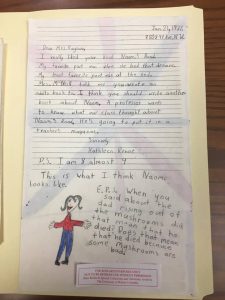Dear readers !
I am very excited to be the class blogger for the end of this semester, especially after having the chance to experience a library outing this month in Rare books and Special Collections at Irving K. Barber Learning Centre.
To introduce us to this new method of research, we got divided into pairs to analyze archives from the work of Joy Kogawa on Obasan. As I mentioned in my blog of this experience, I believe that we were separate based on different period of the creation of the novel. For example, one table has the early drafts like Tiger who address the importance of look in the whole thinking process of the book. By focusing on the growing construction of the novel, we discover a new insight on the content of Kogawa’s work.
I believe that it is a very interesting perspective that we, as UBC scholars, have the chance to access. By reading different blogs posts, I came to the realization that many of my classmate discuss new themes that we did not really elaborate in class because we were not aware of them.
One of the main topic that came back often in the December blog posts was the complex process of the creation of such engaging novel like Obasan. As mentioned in Riley’s blog, Obasan is not just a fictional novel that Joy Kogawa wrote from a personal memory but it also include real testimonies and historical events. I found that very relevant to talk about the fact that the author did not just focus on respecting rules of a specific genre but rather try to make it as most authentic as possible. One aspect Karolina’s blog post really highlight was the way Kogawa hesitated between different titles such as “If I must remember” or “The Colour of the Rain”. I found that very intriguing that she raises question of the choice of the tittle because this gave a new information : not only it gives an insight about the process behind the creation of the novel but also how, paradoxically it make it difficult to guess the real intention of the author. The novel, combined with the drafts documents reveals a lot about the past events and how one choses to remember it.
Thus, Obasan can be considered as a technology of memory that denounce the living condition of a minority group during the Japanese Internment in Canada. Indeed, some of my classmate like Ella has approach the theme of forgetting in the novel. The research in the library combined with class materials show clearly the importance of Kogawa message to the community : forcing them to remember what became a national trauma. Addressed in Jessica’s blog, the novel’s purpose is educational and Kogawa clearly got a lot feedback from a variety of age. In the early attempts of publication, she got many rejection letters from people refusing to remember the Japanese Internment but in other fan mails thanks her for acknowledging the past events and for encouragement to talk more about it.
Interestingly, like many of my classmates, I never really through how much persistence it took for Kogawa to make her book recognize. By looking at the work behind the creation of a novel from rough drafts and edits, Christiana and Jenny realize how the author seems closer and more “human” and that they had a new connection when it is more “solidified that she was a real person”.Looking at drafts like bullet point list or the family trees drafts, Jenny addresses the fact that Kogawa use the same strategies as us to create papers and essays. I also noted Christiana’s idea that the archive documents was completely authentic from the author’s mind, excluding the “intention of publication adds”. In the end, many topics were identical but with a slightly different kind of feeling toward Obasan. Many were intrigued by the behind process of the creation of the book while others prefers to focus on the new message it gives. Some people discover a new connection with the author and acknowledged her persistence to make her novel recognized in the eyes of the public.
I hope that you have all enjoy reading those blogs as much as me. Best of luck for the exams and happy holidays !


